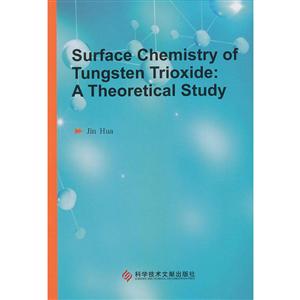-
>
宇宙、量子和人类心灵
-
>
(精)BBC地球故事系列-星际旅行
-
>
从一到无穷大
-
>
图说相对论(32开平装)
-
>
一本有趣又有料的化学书
-
>
刘薰宇的数学三书:原来数学可以这样学全3册
-
>
光学零件制造工艺学
三氧化钨表面化学的理论研究= SURFACE CHEMISTRY OF TUNGSTEN TRIOXIDE: A THE 版权信息
- ISBN:9787518947065
- 条形码:9787518947065 ; 978-7-5189-4706-5
- 装帧:一般胶版纸
- 册数:暂无
- 重量:暂无
- 所属分类:>>
三氧化钨表面化学的理论研究= SURFACE CHEMISTRY OF TUNGSTEN TRIOXIDE: A THE 本书特色
Tungsten trioxide (WO3) is a kind of multifunctional semiconductor materials, and it has been widely used in different fields including photochromism, electrochromism, chemical sensors and so on, for its unique physical and chemical properties. In this work, the electronic structure and surface chemical reactivity of tungsten trioxide semiconductor are systematically investigated by using DFT method. It is hoped that this book would provide reliable theoretical foundation to get deep insight into the origin of the characteristic of WO3based material, as well as designing the new heterogeneous catalysts. The main conclusions of this book are as listed in following.
Tungsten trioxide (WO3) is a kind of multifunctional semiconductor materials, and it has been widely used in different fields including photochromism, electrochromism, chemical sensors and so on, for its unique physical and chemical properties. In this work, the electronic structure and surface chemical reactivity of tungsten trioxide semiconductor are systematically investigated by using DFT method. It is hoped that this book would provide reliable theoretical foundation to get deep insight into the origin of the characteristic of WO3based material, as well as designing the new heterogeneous catalysts. The main conclusions of this book are as listed in following.
1. The structural and electronic properties of seven WO3 bulk phases have been studied. Our calculations indicate that, among these phases the simple cubic structure is the least stable, but the energy difference between different WO3 phases is small (
三氧化钨表面化学的理论研究= SURFACE CHEMISTRY OF TUNGSTEN TRIOXIDE: A THE 内容简介
三氧化钨(WO3)是一类重要的功能材料,因具有独特的光致/电致变色和气敏/湿敏特性,以及其在多相催化和光催化等领域中的重要应用而备受关注。金华著的《三氧化钨表面化学的理论研究(英文版)》主要运用密度泛函理论(DFT)方法,综合分析了三氧化钨半导体材料的电子结构和表面化学反应性质,包括三氧化钨体相及表面的几何结构和电子性质、表面催化氧化活性及掺杂改性等多个方面。为深入了解该类功能材料特性的来源和相关多相催化剂的设计与研制提供可靠的理论依据。
三氧化钨表面化学的理论研究= SURFACE CHEMISTRY OF TUNGSTEN TRIOXIDE: A THE 目录
- >
莉莉和章鱼
莉莉和章鱼
¥18.1¥42.0 - >
烟与镜
烟与镜
¥20.6¥48.0 - >
企鹅口袋书系列·伟大的思想20:论自然选择(英汉双语)
企鹅口袋书系列·伟大的思想20:论自然选择(英汉双语)
¥6.3¥14.0 - >
月亮与六便士
月亮与六便士
¥13.4¥42.0 - >
自卑与超越
自卑与超越
¥13.5¥39.8 - >
名家带你读鲁迅:朝花夕拾
名家带你读鲁迅:朝花夕拾
¥10.5¥21.0 - >
人文阅读与收藏·良友文学丛书:一天的工作
人文阅读与收藏·良友文学丛书:一天的工作
¥18.3¥45.8 - >
中国人在乌苏里边疆区:历史与人类学概述
中国人在乌苏里边疆区:历史与人类学概述
¥24.0¥48.0
-
2022图书×抽奖盲袋
¥9.9¥25 -
2023读书月阅读盲盒——天黑,闭眼,刀谁?
¥42.3¥158 -
2022读者节纪念徽章-三星会员专属
¥45¥45.6 -
2023读书月阅读盲盒——我什么场面没见过?
¥42.3¥158 -
2023读书月阅读盲盒——去码头整点什么薯条?
¥42.3¥158
















